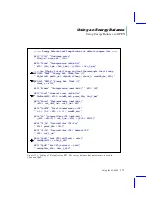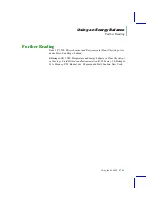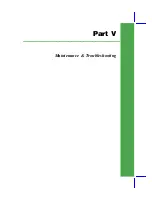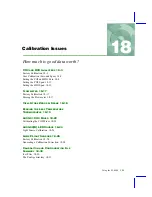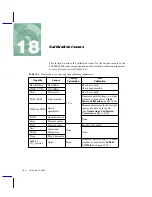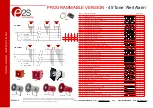
Using an Energy Balance
Using Energy Balance in OPEN
17-8
Using the LI-6400
17
Each of these compute lists add two new user variables,
EBdT
and
EBTlf
. The
first uses the LPL function
EB_DeltaT()
to compute the leaf-air temperature
difference. This function implements Equation (17-8), takes five parameters,
and returns the leaf-air temperature difference (Table 15-3 on page 15-15).
EB_DeltaT( parIn_um * alphaK, tCham_c, tLeaf_C,
condBL_one, #20)
Absorbed Energy
The first parameter is the energy absorbed by the leaf. The global variable
al-
phaK
is the product of the two multipliers (
and
k
is given in Table 17-1 on page 17-4, and is set via the Lightsource= configu-
ration command (page 16-21). The variable
parIn_um
is the current reading
of the in-chamber light sensor.
If the chamber has a clear bottom, then the incident PAR would be larger than
measured by the uplooking chamber light sensor. For this reason, in the Com-
puteList file Ò
Clear Bottom EB
Ó, the call to
EB_DeltaT
looks a bit different:
EB_DeltaT( parIn_um * alphaK * 1.2,tCham_c,tLeaf_C,condBL_one,#20)
The
parIn_um
value is increased 20% to account for the clear bottom.
The third variation on the theme is provided by Ò
Conifer Chamber EB
Ó, which has
no in-chamber PAR sensor, so the external one must be used. Accordingly,
the call to
EB_DeltaT
looks like this:
EB_DeltaT( parOut_um * alphaK, tCham_c, tLeaf_C, condBL_one, #20)
Wall Temperature
The second parameter needed for the
EB_DeltaT
function is wall tempera-
ture. The LI-6400 doesnÕt have such a sensor per se, but the air temperature
thermistor is located in the IRGA beneath the air circulation fan. Between this
location and the leaf chamber, the air comes in contact with a lot of metal wall
material, so this sensorÕs signal is not a bad first guess for wall temperature.
However, the metal and Propafilm pieces of the leaf chamber itself will be
modified by external air, but we have no way of measuring that with the de-
fault instrument. Thus, we use
tCham_C
for wall temperature.
If the coolers
are on, then the farther the set point is from ambient temperature, the worse
this assumption becomes.
Fortunately, however, wall temperature is not that
critical in the analysis.
a
Summary of Contents for LI-6400
Page 1: ...Using the LI 6400 Portable Photosynthesis System ...
Page 15: ...Part I The Basics ...
Page 16: ......
Page 174: ...Making Measurements Answers to Questions 4 56 Using the LI 6400 4 ...
Page 175: ...Part II Useful Details ...
Page 176: ......
Page 200: ...Standard Tools Power ON Hooks 5 24 Using the LI 6400 5 ...
Page 214: ...Real Time Data Real Time Graphics 6 14 Using the LI 6400 6 ...
Page 234: ...Environmental Control Light Control 7 20 Using the LI 6400 7 ...
Page 244: ...Light Sensor Considerations Gallium Arsenide Phosphide GaAsP Sensor 8 10 Using the LI 6400 8 ...
Page 288: ...Data Logging Making Your Own AutoPrograms 9 44 Using the LI 6400 9 ...
Page 289: ...Part III Working With Files ...
Page 290: ......
Page 312: ...The LPL File System Troubleshooting 10 22 Using the LI 6400 10 ...
Page 340: ...Downloading Files Using a Data Capture Program 11 28 Using the LI 6400 11 ...
Page 375: ...Part IV Configuration Issues ...
Page 376: ......
Page 420: ...Defining User Variables Old Style vs New Style 15 18 Using the LI 6400 15 ...
Page 454: ...Using an Energy Balance Further Reading 17 12 Using the LI 6400 17 ...
Page 455: ...Part V Maintenance Troubleshooting ...
Page 456: ......
Page 572: ...Troubleshooting Useful Information 20 46 Using the LI 6400 20 ...
Page 593: ...Part VI Programming ...
Page 594: ......
Page 622: ...Programming with LPL Compiler Directives 22 28 Using the LI 6400 22 ...
Page 846: ...Index I 16 Using the LI 6400 ...














